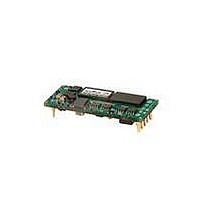UCE-12/10-D48NB-C Murata Power Solutions Inc, UCE-12/10-D48NB-C Datasheet - Page 10

UCE-12/10-D48NB-C
Manufacturer Part Number
UCE-12/10-D48NB-C
Description
CONV DC/DC 120W 12V 10A W/BASEPL
Manufacturer
Murata Power Solutions Inc
Series
UCEr
Type
Isolatedr
Datasheet
1.UCE-3.315-D48NB-C.pdf
(17 pages)
Specifications of UCE-12/10-D48NB-C
Number Of Outputs
1
Output
12V
Power (watts)
120W
Mounting Type
Through Hole
Voltage - Input
36 ~ 75V
Package / Case
8-DIP Module, 1/8 Brick
1st Output
12 VDC @ 10A
Size / Dimension
2.30" L x 0.90" W x 0.50" H (58.4mm x 22.9mm x 12.7mm)
Power (watts) - Rated
120W
Operating Temperature
-40°C ~ 85°C
Efficiency
90%
Approvals
CSA, cUL, EN, IEC, UL
Output Power
120 W
Input Voltage Range
36 V to 75 V
Input Voltage (nominal)
48 V
Output Voltage (channel 1)
12 V
Output Current (channel 1)
10 A
Package / Case Size
Eighth Brick
Output Voltage
12 V
Lead Free Status / RoHS Status
Lead free / RoHS Compliant
3rd Output
-
2nd Output
-
4th Output
-
Lead Free Status / Rohs Status
Lead free / RoHS Compliant
Other names
811-2210-5
If the short-circuit condition persists, another shutdown cycle will initiate. This
rapid on/off cycling is called “hiccup mode.” The hiccup cycling reduces the
average output current, thereby preventing excessive internal temperatures
and/or component damage.
because you do not have to power down the converter to make it restart. The
system will automatically restore operation as soon as the short circuit condi-
tion is removed.
Remote Sense Input
Use the Sense inputs with caution. Sense is normally connected at the load.
Sense inputs compensate for output voltage inaccuracy delivered at the load.
This is done by correcting IR voltage drops along the output wiring and the
current carrying capacity of PC board etch. This output drop (the difference
between Sense and Vout when measured at the converter) should not exceed
0.5V. Consider using heavier wire if this drop is excessive. Sense inputs also
improve the stability of the converter and load system by optimizing the control
loop phase margin.
low value resistors to their respective polarities so that the converter can
operate without external connection to the Sense. Nevertheless, if the Sense
function is not used for remote regulation, the user should connect +Sense to
+Vout and –Sense to –Vout at the converter pins.
coupled to the output lines and therefore are in the feedback control loop to
regulate and stabilize the output. As such, they are not low impedance inputs
and must be treated with care in PC board layouts. Sense lines on the PCB
should run adjacent to DC signals, preferably Ground. In cables and discrete
wiring, use twisted pair, shielded tubing or similar techniques.
Sense control loop can adversely affect overall system stability. If in doubt, test
your applications by observing the converter’s output transient response during
step loads. There should not be any appreciable ringing or oscillation. You
may also adjust the output trim slightly to compensate for voltage loss in any
external fi lter elements. Do not exceed maximum power ratings.
Sense pin. Therefore excessive voltage differences between Vout and Sense
together with trim adjustment of the output can cause the overvoltage protec-
tion circuit to activate and shut down the output.
output current and the highest output voltage. Therefore the designer must
insure:
The “hiccup” system differs from older latching short circuit systems
Note: The Sense input and power Vout lines are internally connected through
The remote Sense lines carry very little current. They are also capacitively
Any long, distributed wiring and/or signifi cant inductance introduced into the
Please observe Sense inputs tolerance to avoid improper operation:
[Vout(+) −Vout(-)] − [Sense(+) −Sense(-)] ≤ 10% of Vout
Output overvoltage protection is monitored at the output voltage pin, not the
Power derating of the converter is based on the combination of maximum
(Vout at pins) x (Iout)
≤
(Max. rated output power)
www.murata-ps.com
Trimming the Output Voltage
The Trim input to the converter allows the user to adjust the output voltage
over the rated trim range (please refer to the Specifi cations). In the trim equa-
tions and circuit diagrams that follow, trim adjustments use either a trimpot or
a single fi xed resistor connected between the Trim input and either the +Sense
or –Sense terminals. (On some converters, an external user-supplied precision
DC voltage may also be used for trimming). Trimming resistors should have a
low temperature coeffi cient (±100 ppm/deg.C or less) and be mounted close
to the converter. Keep leads short. If the trim function is not used, leave the
trim unconnected. With no trim, the converter will exhibit its specifi ed output
voltage accuracy.
the maximum output voltage OR the maximum output power when setting the
trim. Be particularly careful with a trimpot. If the output voltage is excessive,
the OVP circuit may inadvertantly shut down the converter. If the maximum
power is exceeded, the converter may enter current limiting. If the power is
exceeded for an extended period, the converter may overheat and encounter
overtemperature shut down.
input to the converter’s feedback control loop. Excessive electrical noise may
cause instability or oscillation. Keep external connections short to the Trim
input. Use shielding if needed.
There are two CAUTIONs to observe for the Trim input:
CAUTION: To avoid unplanned power down cycles, do not exceed EITHER
CAUTION: Be careful of external electrical noise. The Trim input is a senstive
1
3
4
−
ON/OFF
CONTROL
+INPUT
INPUT
Figure 4. Remote Sense Circuit Confi guration
Isolated, High-Density, Eighth-Brick
+OUTPUT
-OUTPUT
+SENSE
−
SENSE
TRIM
Low Profi le DC/DC Converters
21 Feb 2011
5
6
7
8
9
Contact and PCB resistance
Contact and PCB resistance
Sense Current
Sense Return
I
losses due to IR drops
losses due to IR drops
OUT
I
OUT
email: sales@murata-ps.com
Return
UCE Series
MDC_UCE.A30 Page 10 of 17
LOAD


















